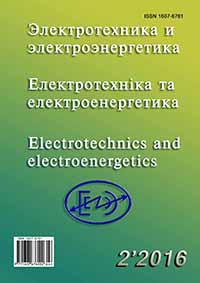RESEARCH OF SUCCESSIVE EXCITATION ELECTRIC MOTOR DYNAMIC MODES WITH PULSED SCHEMES OF THE ELECTRIC DRIVE REGULATION
DOI:
https://doi.org/10.15588/1607-6761-2016-2-6Keywords:
pulse control, the electric motor of series excitation, series excitation, simulation modelAbstract
Purpose: The purpose of the work is to research the dynamics of DC motor of series excitation with pulse speed control and determine the possibility of the drive circuit simplification.
Research methods: With the help of simulation and analytical methods of calculation techniques developed a simulation model, identified the advantages of using a modernized impulse control scheme.
The obtained results: The modernized scheme of series excitation DC current motor pulse control is designed. For the proposed and existing pulse regulation schemes the models are developed; they help to investigate the electromechanical processes of electric drive in these schemes and to perform the comparative analysis. The results of the modernized DC motor speed impulse control scheme investigation in the acceleration mode, overrun and electro-dynamic braking are given.
Scientific novelty: Developed advanced pulse regulating sequential excitation DC motor scheme. For existing and proposed schemes impulse regulation developed models that allow study of electromechanical processes in electric drive for existing and proposed impulse control schemes.
The practical significance: It is shown that the addition of a shunt field winding diode to pulsed regulator scheme reducing the rate of current decay in the winding. It is determined that the proposed upgrade allows to use electro-dynamic braking mode at the motor self-excitation. The proposed scheme design avoids the use of additional independent power sources and simplify the technical implementation and reduce costs.
References
Метельський В. П. Електричні машини та мікромашини / В. П. Метельський. – Запоріжжя: ЗНТУ, 2005. – 616 с.
Глазенко Т. А. Полупроводниковые преобразователи в электроприводах постоянного тока / Т. А. Глазенко. – Л.: Энергия, 1973. – 304 с.
Андриенко П. Д. Исследование режимов торможения в системе импульсного регулирования сериесного электродвигателя / П.Д. Андриенко, А.О. Каплиенко, С. И. Шило, И. Ю. Немудрый // Електротехніка та електроенергетика. – 2007. – № 2. – С. 11–14.
Герман-Галкин С. Г. Силовая электроника: Лабораторные работы на ПК / С. Г. Герман-Галкин. – СПб.: Учитель и ученик, Корона-принт, 2002. – 304 с.
Герман-Галкин С. Г. Электрические машины: Лабораторные работы на ПК / С. Г. Герман-Галкин, Кардонов Г. А. – СПб.: Учитель и ученик, Корона-принт, 2003. – 256 с.
Герман-Галкин С. Г. Компьютерное моделирование полупроводниковых систем / С.Г. Герман-Галкин – СПб.: Учитель и ученик, Корона-принт, 2001. – 319с.
Перльмутер В. М. Системы управления тиристорными электроприводами постоянного тока / В. М. Перльмутер, В. А. Сидоренко. – М.: Энергоатомиздат, 1988. – 304 с.
Пегов Д. В. Руководство по устройству электропоездов ЭТ2, ЭР2Т, ЭД2Т, ЭТ2М / Д. В. Пегов, П. В. Бурцев, В. Е. Андреев – Москва: Центр коммерческих разработок, 2003. – 184 с.
Downloads
How to Cite
Issue
Section
License
Copyright (c) 2017 P. D. Andrienko, S. I. Shilo, O. O. Kaplienko

This work is licensed under a Creative Commons Attribution 4.0 International License.
Creative Commons Licensing Notifications in the Copyright Notices
Authors who publish with this journal agree to the following terms:
Authors retain copyright and grant the journal right of first publication with the work simultaneously licensed under aCreative Commons Attribution License that allows others to share the work with an acknowledgement of the work's authorship and initial publication in this journal.
Authors are able to enter into separate, additional contractual arrangements for the non-exclusive distribution of the journal's published version of the work (e.g., post it to an institutional repository or publish it in a book), with an acknowledgement of its initial publication in this journal.
Authors are permitted and encouraged to post their work online (e.g., in institutional repositories or on their website) prior to and during the submission process, as it can lead to productive exchanges, as well as earlier and greater citation of published work.

